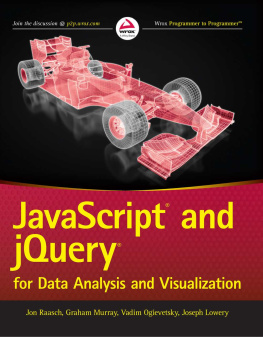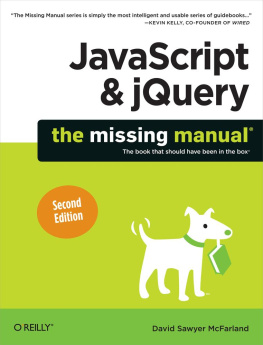Kaustubh S. Mayekar
Foreword
I feel honored knowing that Karl Swedberg and Jonathan Chaffer undertook the task of writing Learning jQuery. As the first book about jQuery, it set the standard that other jQueryand really, other JavaScript books in generalhave tried to match. It's consistently been one of the top-selling JavaScript books since its release, in no small part due to its quality and attention to detail.
I'm especially pleased that it was Karl and Jonathan who wrote the book since I already knew them so well and knew that they would be perfect for the job. Being part of the core jQuery team, I've had the opportunity to come to know Karl quite well over the past couple of years, and especially within the context of his book-writing effort. Looking at the end result, it's clear that his skills as both a developer and a former English teacher were perfectly designed for this singular task.
I've also had the opportunity to meet both of them in person, a rare occurrence in the world of distributed open source projects, and they continue to be upstanding members of the jQuery community.
The jQuery library is used by so many different people in the jQuery community. The community is full of designers, developers, people who have experience in programming, and those who don't. Even within the jQuery team, we have people from all backgrounds providing their feedback on the direction of the project. There is one thing that is common across all of jQuery's users: we are a community of developers and designers who want JavaScript development to be made simple.
It's almost a clich, at this point, to say that an open source project is community-oriented, or that a project wants to focus on helping new users get started. But it's not just an empty gesture for jQuery; it's the liquid-oxygen fuel for the project. We actually have more people in the jQuery team dedicated to managing the jQuery community, writing documentation, or writing plugins than actually maintaining the core code base. While the health of the library is incredibly important, the community surrounding that code is the difference between a floundering, mediocre project, and one that will match and exceed your every need.
How we run the project and how you use the code is fundamentally very different from most open source projectsand most JavaScript libraries. The jQuery project and community is incredibly knowledgeable; we understand what makes jQuery a different programming experience and do our best to pass that knowledge on to fellow users.
The jQuery community isn't something that you can read about to understand; it's something that you actually have to participate in for it to fully sink in. I hope that you'll have the opportunity to partake in it. Come join us in our forums, mailing lists, and blogs and let us help guide through the experience of getting to know jQuery better.
For me, jQuery is much more than a block of code. It's the sum of total experiences that have transpired over the years in order to make the library happen. The considerable ups and downs and the struggle of development together with the excitement of seeing it grow and succeed. Growing close with its users and fellow team members, understanding them and trying to grow and adapt.
When I first saw this book talk about jQuery and discuss it like a unified tool, as opposed to the experiences that it's come to encapsulate for me, I was taken aback and excited. Seeing how others learn, understand, and mold jQuery to fit them is much of what makes the project so exhilarating.
I'm not the only one who enjoys jQuery on a level that is far different from a normal tool-user relationship. I don't know if I can properly encapsulate why this is, but I've seen it time and time againthe singular moment when a user's face lights up with the realization of just how much jQuery will help them.
There is a specific moment where it just clicks for a jQuery user when they realize that this tool that they were using was in fact much more than just a simple tool all alongand suddenly their understanding of how to write dynamic web applications completely shifts. It's an incredible thing and absolutely my favorite part of the jQuery project.
I hope you'll have the opportunity to experience this sensation as well.
John Resig
Creator of jQuery
About the Authors
Jonathan Chaffer is a member of Rapid Development Group, a web development firm located in Grand Rapids, Michigan. His work there includes overseeing and implementing projects in a wide variety of technologies, with an emphasis in PHP, MySQL, and JavaScript. He also leads on-site training seminars on the jQuery framework for web developers.
In the open source community, he has been very active in the Drupal CMS project, which has adopted jQuery as its JavaScript framework of choice. He is the creator of the Content Construction Kit, a popular module for managing structured content on Drupal sites. He is also responsible for major overhauls of Drupal's menu system and developer API reference.
He lives in Grand Rapids with his wife, Jennifer.
I would like to thank Jenny for her tireless enthusiasm and support, Karl for the motivation to continue writing when the spirit is weak, and the Ars Technica community for constant inspiration toward technical excellence. In addition, I'd like to thank Mike Henry and the Twisted Pixel team for producing consistently entertaining distractions in between writing sessions.
Karl Swedberg


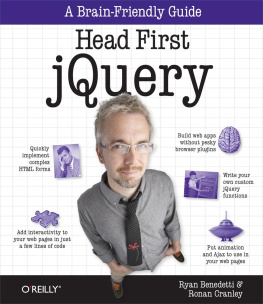
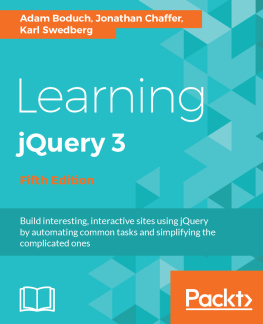

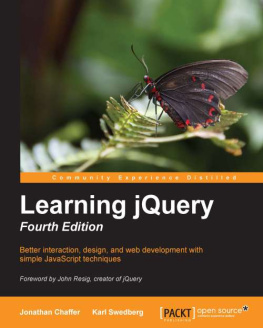
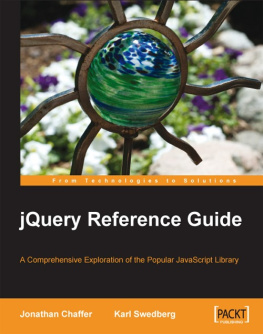
![Jon Duckett [Jon Duckett] - JavaScript and JQuery: Interactive Front-End Web Development](/uploads/posts/book/120511/thumbs/jon-duckett-jon-duckett-javascript-and-jquery.jpg)

